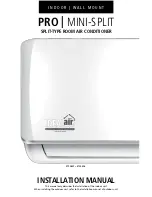
Installation
Climate 5000 MS – 6721830162 (2020/12)
34
Table 14 Key data of pipe connections
3.5.2
Connecting condensate pipe to the wall-mounted indoor
unit
The condensation catch pan of the indoor unit has two connections. A
condensate hose and bung are mounted on these connections at the
factory and can be replaced (
Fig. 19).
▶ Only route the condensate hose with a slope.
3.5.3
Connecting condensate pipe to the ceiling-mounted indoor
units
▶ Use PVC pipes with 32 mm inside diameter and 5-7 mm wall
thickness.
▶ Insulate drain pipe to prevent condensate formation.
▶ Connect drain pipe to indoor unit and secure connection with a hose
clip.
▶ Install drain pipe on slope (
Fig. 34 or Fig. 43). When a condensate
pump is installed, the outlet of the drain pipe may be higher than the
indoor unit if the dimensions and wiring diagram are observed.
NOTICE
Danger due to water damage!
If the pipes are routed incorrectly, water may be discharged, or may flow
back into the indoor unit and cause the water level switch to malfunction.
▶ To prevent the pipes from sagging, install a support every 1–1.5 m.
▶ Route a drain pipe to the sewer via a siphon.
3.5.4
Testing the condensate pipe
Testing the condensate pipe ensures that all connections are tight.
▶ Test the condensate pipe before closing the ceiling.
Indoor unit without a drainage pump
▶ Fill the condensation catch pan or water injection pipe with roughly
2 l of water.
▶ Make sure that the condensate drains away properly.
▶ Check tightness of all connections.
Indoor unit with a drainage pump
The condensate pipe can only be tested once the electrical connection
has been established.
▶ Fill the condensation catch pan or water injection pipe with roughly
2 l of water (for built-in ducted indoor units
Fig. 44).
▶ Switch on cooling mode. The drainage pump can be heard.
▶ Make sure that the condensate drains away properly.
▶ Check tightness of all connections.
3.5.5
Checking tightness and filling the system
Carry out the tightness test and filling for every connected indoor unit
individually.
▶ Once the entire system has been filled, put the cover for the pipe
connections on the outdoor unit back on.
Checking tightness
Observe the national and local regulations when carrying out the
tightness test.
▶ Remove the caps of the valves of a connection pair
(
▶ Connect the Schrader opener [6] and pressure gauge [4] to the
Schrader valve [1].
▶ Screw in the Schrader opener and open the Schrader valve [1].
▶ Leave valves [2] and [3] closed and fill the pipes with nitrogen until
the pressure is 10 % above the maximum operating pressure
(
▶ Check whether the pressure is still the same after 10 minutes.
▶ Discharge the nitrogen until the maximum operating pressure is
reached.
▶ Check whether the pressure is still the same after at least 1 hour.
▶ Discharge nitrogen.
Filling the system
NOTICE
Malfunction due to incorrect refrigerant
The outdoor unit is filled with R32 refrigerant at the factory.
▶ If refrigerant needs to be topped up, only use the same refrigerant.
Do not mix refrigerant types.
▶ Evacuate and dry the pipes with a vacuum pump (
Fig. 11, [5]) for
at least 30 minutes at roughly −1 bar (approx. 500 microns).
▶ Open valve [3] on liquid side.
▶ Use a pressure gauge [4] to check whether the flow is unobstructed.
▶ Open valve [2] on gas side.
The refrigerant is distributed round the connected pipes.
▶ Afterwards, check the pressure ratios.
▶ Unscrew the Schrader opener [6] and close the Schrader valve [1].
▶ Remove the vacuum pump, pressure gauge and Schrader opener.
▶ Reattach the valve caps.
External diameter of pipe Ø
[mm]
Tightening torque [Nm]
Flared opening diameter
(A) [mm]
Flared pipe end
Pre-assembled flare nut
thread
6.35 (1/4")
18-20
8.4-8.7
3/8"
9.53 (3/8")
32-39
13.2-13.5
3/8"
12.7 (1/2")
49-59
16.2-16.5
5/8"
15.9 (5/8")
57-71
19.2-19.7
3/4"
R0.4~0.8
A
45°± 2
90°± 4
















































